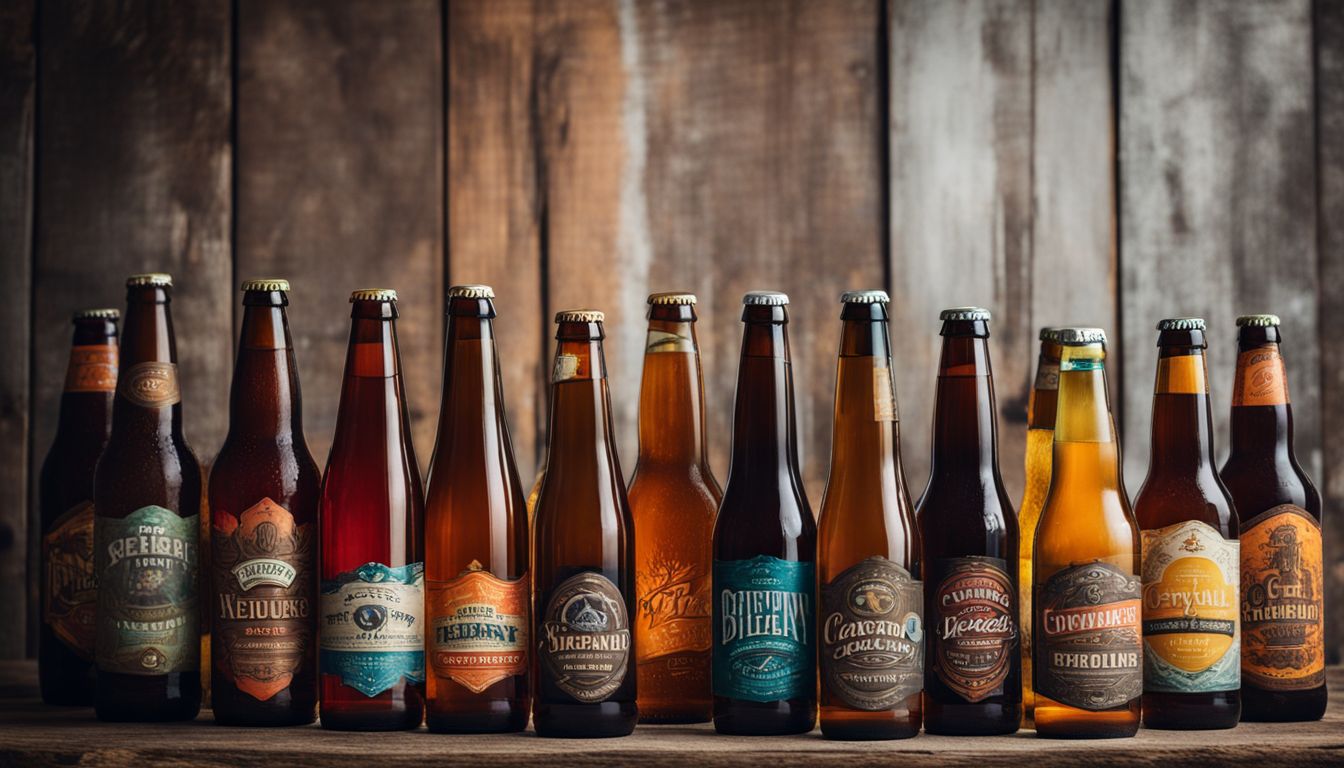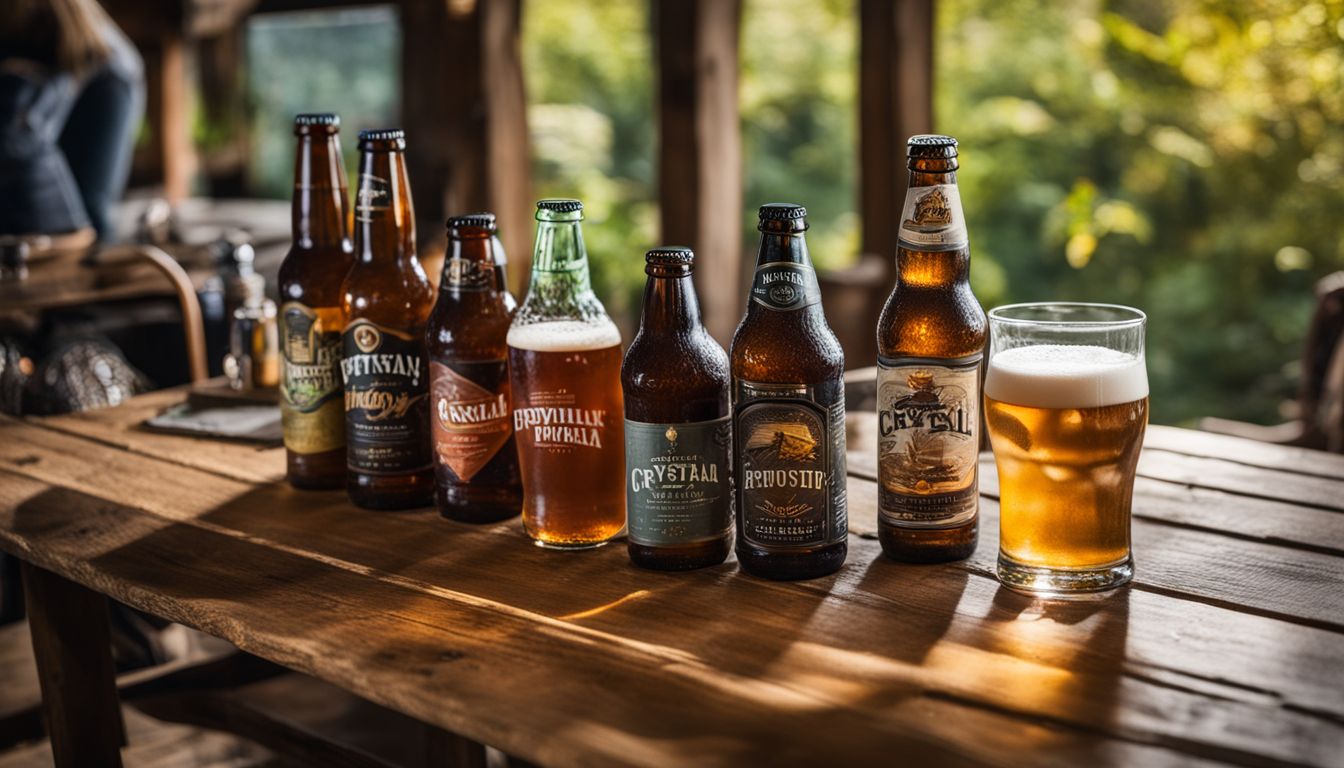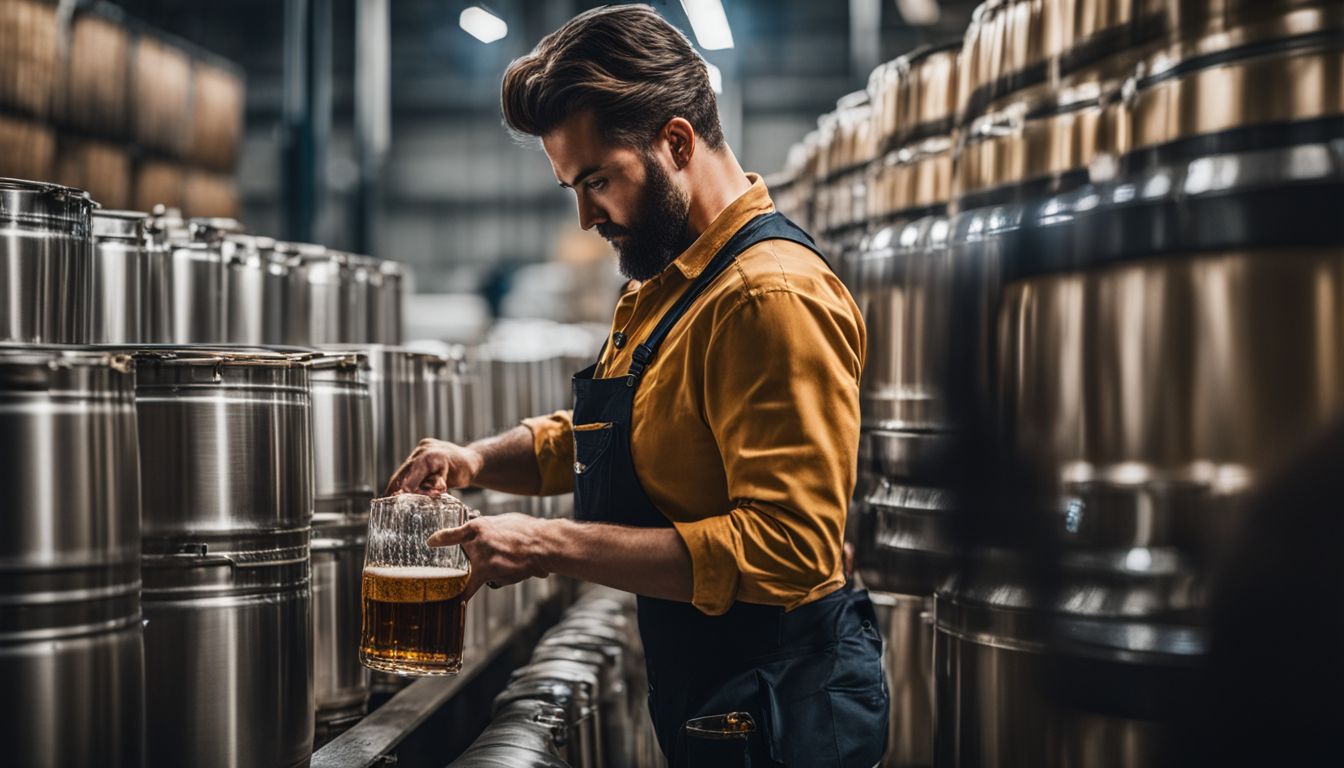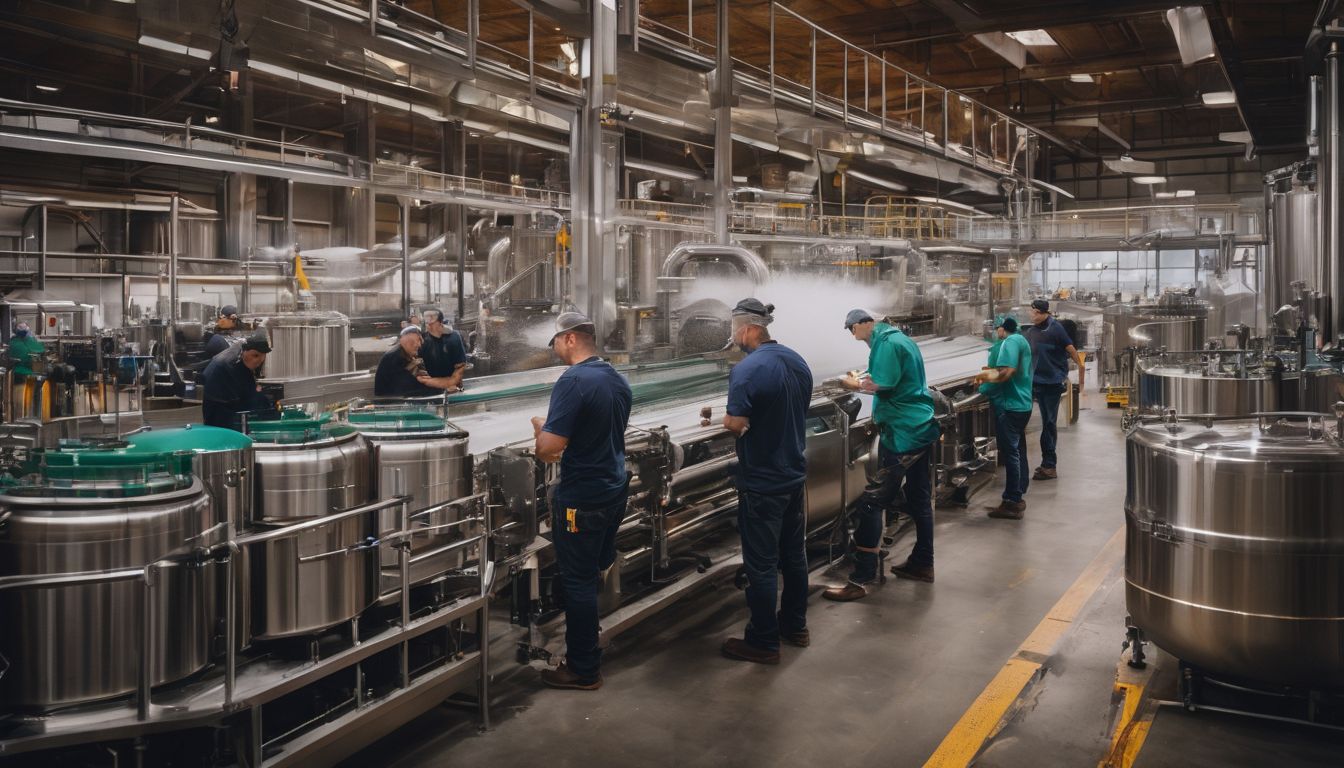Are you eager to grasp the rapidly evolving dynamics of the global beer industry? With the market projected to reach $1,072.50 billion by 2030, there’s no denying its remarkable growth potential.
This comprehensive analysis will navigate you through the latest trends and challenges disrupting this lucrative sector, from the craft beer revolution to supply chain headaches brought about by COVID-19.
Intrigued? Read on for a refreshing insight into your beloved beverage!
Key Takeaways
- Craft beer has revolutionized the beer industry, offering unique and high – quality brews that consumers love.
- Microbreweries are on the rise, crafting flavorful beers with attention to detail and supporting local communities.
- The beer industry is prioritizing sustainability with eco – friendly practices, innovative packaging solutions, and organic ingredients.
- There is a growing trend towards innovation in flavors and styles, providing consumers with more diverse drinking options.
- Low-alcohol and non-alcoholic beers are becoming increasingly popular as people seek healthier alternatives without compromising taste.
- Online beer sales and direct-to-consumer models have expanded, giving consumers convenient access to a wide selection of beers from around the world.
- The beer industry faces challenges from competition with other alcoholic beverages, regulatory issues, rising production costs, changing consumer preferences, health concerns, and supply chain disruptions.
- Despite these challenges, craft beer and microbreweries will continue to thrive by focusing on local appeal and diversifying product offerings.
Latest Trends in the Beer Industry

Craft beer has revolutionized the industry, with microbreweries gaining popularity as consumers seek unique and high-quality brews.
Craft beer revolution

People love craft beer. They enjoy the many types and flavors that are not in normal beers. Craft beer has changed how people think about beer. It was small before, but now it is big and keeps getting bigger.
This growth makes the beer market change fast. Beer makers try to be different and make better quality beers than others. Craft beer fell by 9% in 2020 because of the disease that spread around the world, but we know it will grow again soon.
Rise of microbreweries

Microbreweries have been on the rise in the beer industry, offering a refreshing change for beer lovers. These small-scale breweries focus on crafting unique and flavorful beers with high-quality ingredients.
They pride themselves on their attention to detail and experimentation, resulting in a wide variety of beer styles to choose from. Microbreweries also provide opportunities for local communities by creating jobs and supporting local farmers and suppliers.
With their emphasis on creativity and craftsmanship, microbreweries are reshaping the beer landscape and giving consumers more options than ever before. So if you’re looking for something new and exciting to try, why not visit your local microbrewery?.
Focus on sustainability and eco-friendly practices

The beer industry is placing a strong emphasis on sustainability and eco-friendly practices. Breweries are implementing measures to reduce their environmental impact by conserving water, using renewable energy sources, and minimizing waste.
Many breweries are adopting innovative packaging solutions that are more eco-friendly, such as using recycled materials or biodegradable containers. Additionally, there is a growing trend towards organic ingredients and supporting local farmers.
By prioritizing sustainability, the beer industry aims to not only protect the environment but also meet the increasing demand from environmentally-conscious consumers for more sustainable products.
Innovation in beer flavors and styles

The beer industry has been experiencing innovation in flavors and styles, offering beer drinkers a wider range of options to choose from. Brewers have been experimenting with unique ingredients, such as fruits, spices, and even herbs, to create interesting flavor profiles.
This has led to the introduction of new beer styles that cater to various taste preferences. Moreover, there is a growing trend towards barrel-aged beers, sour beers, and hazy IPAs.
These innovative flavors and styles provide consumers with a more diverse and exciting drinking experience.
Growing demand for low-alcohol and non-alcoholic beers

Low-alcohol and non-alcoholic beers are becoming increasingly popular among beer drinkers. People are looking for options that allow them to enjoy the taste of beer without the high alcohol content.
This demand is driven by various factors, including health-consciousness and responsible drinking habits. These beers offer a refreshing alternative for those who want to cut down on their alcohol intake or abstain completely.
The market for low-alcohol and non-alcoholic beers is expected to continue growing in the coming years as more breweries introduce these options to cater to changing consumer preferences.
Expansion of online beer sales and direct-to-consumer models

The beer industry is seeing a significant expansion in online sales and direct-to-consumer models. This means that beer drinkers now have the convenience of ordering their favorite beers from the comfort of their own homes, without having to visit a physical store.
With just a few clicks, they can browse through a wide variety of craft beers, microbrews, and specialty brews, and have them delivered straight to their doorstep. This trend has been accelerated by the COVID-19 pandemic as more people turned to online shopping due to lockdown restrictions.
It offers beer enthusiasts access to a wider selection of beers from around the world, allowing them to explore new flavors and styles without limitations. Additionally, it provides an opportunity for smaller breweries to reach a larger audience and bypass traditional distribution channels.
Key Challenges in the Beer Industry

Competition from other alcoholic beverages, regulatory issues and licensing requirements, rising production costs and supply chain challenges, changing consumer preferences and tastes, health concerns and increased focus on wellness, impact of COVID-19 pandemic on the industry.
Competition from other alcoholic beverages

The beer industry faces tough competition from other alcoholic beverages. With wine, spirits, and even hard seltzers gaining popularity, beer companies are vying for consumers’ attention and wallet share.
This increased competition means that breweries need to work harder to differentiate themselves and attract customers. Beer makers need to understand changing consumer preferences, adapt their product offerings, and find unique ways to stand out in a crowded market.
Despite these challenges, the global beer market is still growing steadily and offers opportunities for breweries to thrive.
Regulatory issues and licensing requirements

The beer industry is subject to various regulatory issues and licensing requirements that breweries must comply with. These regulations are put in place to ensure the safety and quality of beer, as well as protect consumers from potential harm.
Breweries need to obtain licenses and permits from government agencies to operate legally, which can vary depending on the location.
Additionally, breweries must adhere to specific labeling and packaging guidelines, such as accurately listing ingredients, alcohol content, and health warnings. Compliance with tax regulations is also crucial for breweries to avoid penalties or legal complications.
These regulatory issues can pose challenges for brewers, especially smaller craft breweries that may have limited resources or knowledge in navigating complex regulations. However, adhering to these requirements is essential for maintaining consumer trust and ensuring a level playing field within the industry.
Rising production costs and supply chain challenges

The beer industry is currently facing rising production costs and supply chain challenges. Expenses such as raw materials, labor, packaging, and transportation have been increasing, putting pressure on breweries to maintain profitability.
Additionally, the supply chain has been disrupted by factors like carbon dioxide shortages and labor market tightness. These challenges can lead to higher prices for consumers and potential difficulties in meeting demand.
Breweries are navigating these obstacles by implementing cost-saving measures, exploring sustainable practices, and forming strategic partnerships with suppliers and distributors to ensure a steady flow of ingredients and products.
Changing consumer preferences and tastes

Consumers are constantly changing their preferences and tastes when it comes to beer. They are looking for unique and flavorful options that go beyond traditional styles. Craft beer has become increasingly popular, with its focus on quality and innovation.
People are also interested in low-alcohol and non-alcoholic beers as they prioritize wellness and health. Additionally, consumers now have the option to purchase beer online, making it more convenient than ever before.
As a result, breweries need to stay agile and adapt to these evolving consumer demands in order to remain successful in the industry.
Health concerns and increased focus on wellness
Consumers are becoming more health-conscious, and this trend is also affecting the beer industry. People are paying attention to their wellness and considering the impact of alcohol on their bodies.
As a result, there is a growing demand for low-alcohol and non-alcoholic beers that provide a lighter drinking experience. Additionally, consumers are seeking out beers with natural ingredients and fewer additives.
This focus on wellness has pushed breweries to innovate and create options that cater to these preferences. With concerns about health on the rise, breweries need to adapt by offering healthier beer choices while still delivering on taste and quality.
Impact of COVID-19 pandemic on the industry
The COVID-19 pandemic has had a big impact on the beer industry. Production of craft beer went down by 9% in 2020 because of the pandemic. People were not going out as much, which meant less demand for beer.
It also changed how people bought and consumed beer, with more people buying online instead of going to bars or restaurants. The pandemic made it harder for breweries to make and distribute their beer.
They faced challenges like shortages of carbon dioxide, tightness in the labor market, rising expenses, and problems with the supply chain. The industry is slowly recovering now, but it was a tough time for brewers during the pandemic.
The Future of the Beer Industry

Craft beer and microbreweries will continue to thrive, with a focus on local and regional beers. Technology integration, sustainable practices, diversification of product offerings, and industry collaboration are key factors shaping the future of the beer industry.
Discover more about the exciting prospects for beer enthusiasts in our comprehensive analysis.
Continued growth of craft beer and microbreweries
Craft beer and microbreweries continue to experience significant growth in the beer industry. These smaller, independent breweries are gaining popularity among beer drinkers because of their unique flavors and local appeal.
In 2020, despite the challenges brought by the pandemic, craft beer production saw a slight decline of 9%. However, with restrictions lifting and consumer demand increasing once again, it is expected that craft beer and microbreweries will continue to thrive in the coming years.
This trend reflects a shift in consumer preferences towards more diverse and artisanal beers. The focus on quality ingredients, innovative brewing techniques, and personalized experiences has propelled the growth of these small-scale breweries.
Emphasis on local and regional beers
One of the emerging trends in the beer industry is a strong emphasis on local and regional beers. People are becoming more interested in supporting their local breweries and trying out beers that are unique to their area.
This trend has gained momentum because it allows consumers to connect with their community and enjoy beers that have a distinct flavor profile influenced by local ingredients and brewing traditions.
With an increased focus on sustainability, buying local also reduces carbon footprint by minimizing transportation distances. This shift towards local and regional beers provides beer drinkers with the opportunity to explore new flavors while supporting small businesses in their own communities.
Integration of technology in brewing processes
Technology plays a crucial role in the brewing industry, helping breweries improve their processes and create better beer. With advancements in technology, brewers can now use automated systems to control temperature, monitor fermentation, and ensure consistency in every batch.
This not only increases efficiency but also allows for greater precision and quality control. Furthermore, technology enables brewers to experiment with new flavors and styles by using innovative ingredients and techniques.
From grain mills to fermentation tanks, technology is revolutionizing the way beer is brewed, ensuring that beer drinkers can enjoy a wide variety of high-quality brews.
Sustainable packaging and production practices
The beer industry is increasingly focusing on sustainable packaging and production practices to reduce its environmental impact. Many breweries are adopting eco-friendly packaging materials, such as aluminum cans and recyclable glass bottles, instead of plastic.
They are also implementing energy-efficient processes in their production facilities to minimize waste and carbon emissions. For example, some breweries are utilizing solar power or investing in renewable energy sources to power their operations.
By prioritizing sustainability, the beer industry aims to contribute towards a greener future while still delivering high-quality beers that consumers can enjoy.
Diversification of product offerings
The beer industry is constantly evolving, with breweries expanding their product offerings to cater to changing consumer preferences. Apart from the traditional beer styles, there has been a rise in flavored beers, such as fruit-infused or barrel-aged options, providing unique and diverse taste experiences.
Additionally, breweries are also exploring the production of low-alcohol and non-alcoholic beers to meet the increasing demand for healthier beverage choices. This diversification of product offerings allows beer drinkers to have a wider selection and discover new flavors that suit their tastes and lifestyle preferences.
Collaboration and partnerships within the industry
Collaboration and partnerships within the beer industry are crucial for growth and innovation. Breweries are teaming up with other breweries, restaurants, and even non-beer brands to create unique and exciting products.
By sharing resources and knowledge, they can experiment with new flavors, styles, and brewing techniques. These collaborations also help in reaching new customers and expanding market reach.
For example, a craft brewery might partner with a local restaurant to create a special beer that pairs well with their menu items. This allows both businesses to attract new customers who may not have tried their products before.
Furthermore, partnerships within the industry also extend beyond product collaborations. Breweries often collaborate on sustainability initiatives such as reducing water consumption or implementing renewable energy sources.
They share best practices and work together towards common goals like minimizing waste or supporting local communities.
Strategies for Success in the Changing Beer Industry

Adapt to evolving consumer preferences, invest in research and development, differentiate your brand through storytelling, expand into new markets and embrace sustainability initiatives.
Adaptation to evolving consumer preferences
To succeed in the changing beer industry, breweries need to adapt to the evolving preferences of consumers. People’s tastes and preferences for beer are constantly changing, so it’s important for brewers to stay ahead of these trends.
This means experimenting with new flavors and styles, keeping up with demand for low-alcohol and non-alcoholic options, and embracing sustainability initiatives. By staying attuned to what consumers want, breweries can continue to thrive in a competitive market.
Did you know that the rise of craft beer has led to a focus on innovation and quality? As more people become interested in unique and flavorful beers, breweries must adapt their offerings accordingly.
Additionally, with an increasing emphasis on health and wellness, consumers are seeking lower alcohol options or even non-alcoholic alternatives. Breweries should consider expanding their product lines to meet this demand.
In conclusion,
Investment in research and development
Investing in research and development is crucial for the beer industry to stay ahead of the competition and meet changing consumer preferences. By conducting research, breweries can discover new brewing techniques, flavors, and ingredients to create unique and innovative beers.
Research also helps improve production processes, sustainability practices, and packaging methods. With technology playing a significant role in the industry, investing in R&D allows breweries to integrate advanced tools and equipment for better efficiency.
By staying proactive with research and development, breweries can continue to offer exciting new products that appeal to beer drinkers’ evolving tastes while also addressing environmental concerns.
Brand differentiation and storytelling
In the ever-evolving beer industry, brand differentiation and storytelling are crucial for success. With so many options available to consumers, breweries need to stand out from the competition and create a unique identity.
This can be achieved through branding strategies that highlight the brewery’s values, history, and brewing process. By telling their story authentically, breweries can connect with customers on a deeper level and build loyalty.
Branding also helps to differentiate beers in a crowded market by showcasing their distinct flavors, styles, and ingredients. Successful breweries understand the importance of effective brand differentiation and use compelling storytelling to capture the attention of beer drinkers.
Expansion into new markets
Craft breweries are increasingly looking to expand into new markets to reach a wider audience of beer drinkers. This expansion allows them to tap into different regions and demographics, opening up opportunities for growth and increased sales.
With the global beer market projected to reach $1072.50 billion by 2030, there is ample room for breweries to explore untapped markets and establish their presence. By identifying consumer preferences and adapting their offerings accordingly, breweries can successfully enter new markets and extend their reach beyond their local communities.
This strategy not only increases revenue potential but also helps in building brand recognition on a larger scale.
Embracing sustainability and environmental initiatives
Craft breweries are increasingly focusing on sustainability and environmental initiatives. They understand the importance of protecting our planet and want to minimize their impact on it.
Many breweries are implementing eco-friendly practices such as using renewable energy sources, reducing water consumption, and recycling waste products. Additionally, they are embracing sustainable packaging options to reduce plastic waste and carbon emissions.
By prioritizing sustainability, these breweries are not only benefiting the environment but also attracting environmentally conscious beer drinkers who value businesses that take proactive steps towards sustainability.
The brewing industry is recognizing the significance of environmental challenges such as water conservation, energy efficiency, and emission control. Breweries are investing in technologies that allow them to monitor and reduce their environmental footprint throughout the production process.
For example, some breweries have installed systems that capture carbon dioxide emitted during fermentation and repurpose it for other uses within the brewery or sell it for industrial applications.
Building strong relationships with suppliers and distributors
To succeed in the changing beer industry, it is crucial for breweries to build strong relationships with their suppliers and distributors. By maintaining good communication and understanding their needs, breweries can ensure a steady supply of high-quality ingredients and materials.
Strong partnerships also help in efficiently distributing their products to retailers and customers. This collaboration enables breweries to meet consumer demands effectively while optimizing production costs.
Working closely with suppliers and distributors allows breweries to adapt quickly to market changes, stay competitive, and continue delivering quality beers that consumers love.
Conclusion

The beer industry is constantly evolving, facing new trends and challenges. From the craft beer revolution to sustainability practices and changing consumer preferences, there’s a lot happening.
The COVID-19 pandemic has also had a significant impact on the industry. To succeed in this changing landscape, breweries must adapt, innovate, and build strong relationships with suppliers and distributors.
It’s an exciting time for the beer industry, full of opportunities for those who embrace change and stay ahead of emerging trends.
FAQs
1. What are some emerging trends in the beer industry?
Some emerging trends in the beer industry include craft breweries, flavored and fruity beers, and a growing demand for low-alcohol or alcohol-free options.
2. What challenges does the beer industry face?
The beer industry faces challenges such as increased competition, changing consumer preferences, regulatory restrictions, and sustainability concerns.
3. How can breweries adapt to the changing trends in the beer industry?
Breweries can adapt to changing trends by experimenting with new flavors and styles, focusing on quality and craftsmanship, embracing sustainable practices, and engaging with consumers through social media and events.
4. Are there any opportunities for growth in the beer industry despite these challenges?
Yes, despite the challenges, there are opportunities for growth in the beer industry such as expanding into international markets, creating unique experiences through brewery tours or taprooms, and collaborating with other businesses to create innovative products.
